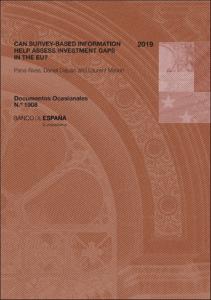Can survey-based information help assess investment gaps in the EU?
Autor
Fecha de publicación
10-may-2019
Descripción física
38 p.
Resumen
Este documento muestra cómo se puede utilizar la información obtenida de bases de datos a nivel individual y de encuestas, junto con indicadores macroeconómicos, para mejorar la comprensión de los obstáculos a la inversión a los que las empresas de la UE se enfrentan. Para ello, utilizamos un conjunto de datos novedoso que combina datos a escala de empresa, provenientes de la Encuesta sobre Inversión y Financiación de la Inversión del Banco Europeo de Inversiones (EIBIS, por sus siglas en inglés), con la información de balance y de pérdidas y ganancias de las empresas. Mostramos que los indicadores de impedimentos a la inversión a nivel país, que se derivan de la agregación de respuestas cualitativas, se correlacionan relativamente bien con los datos macroeconómicos comúnmente considerados como determinantes de la inversión en muchos modelos. Después de controlar por características específicas a escala de empresa, la brecha de inversión percibida (la diferencia entre la inversión deseada y la real) permanece correlacionada con las barreras declaradas. Aunque el acceso a la financiación no es el obstáculo más reportado, es el que provee mayor información. La señal de este impedimento se intensifica cuando es proporcionada por empresas «más débiles», que se definen como aquellas que son más pequeñas, y/o más endeudadas, y/o menos rentables y/o con una menor liquidez. Desde el punto de vista de políticas públicas, nuestros hallazgos sugieren que la información basada en encuestas supone un aporte útil para complementar otras fuentes cuantitativas, tanto individuales como agregadas, proporcionado una información muy útil para el diseño de mejores políticas específicas encaminadas a apoyar la inversión
This study illustrates how information from micro-level and survey-based databases can be used, along with macroeconomic indicators, to provide a better understanding of corporate investment obstacles across the EU. To show this, we use a novel dataset merging firmlevel data from the European Investment Bank Investment Survey (EIBIS) and hard data from corporations’ balance sheet and P&L information. We show that the indicators of impediments to investment at the country level, which can be derived from aggregating qualitative answers, correlate relatively well with macro-based hard data, which are commonly considered as determinants of investments in macro-based models. After controlling for firm-specific characteristics, the perceived investment gap (the difference between desired and actual investment) remains correlated with the reported impediments. While access to finance is not the most reported obstacle, reporting it has the highest information content. Moreover, the signal intensifies when it is given by “weaker” firms, defined as those that are smaller, and/or more indebted, and/or less profitable and/or with lower liquidity positions. From a policy standpoint, our findings suggest that survey-based information can be a useful input to complement both macro and micro hard data and better inform the design of targeted policies to support investment
This study illustrates how information from micro-level and survey-based databases can be used, along with macroeconomic indicators, to provide a better understanding of corporate investment obstacles across the EU. To show this, we use a novel dataset merging firmlevel data from the European Investment Bank Investment Survey (EIBIS) and hard data from corporations’ balance sheet and P&L information. We show that the indicators of impediments to investment at the country level, which can be derived from aggregating qualitative answers, correlate relatively well with macro-based hard data, which are commonly considered as determinants of investments in macro-based models. After controlling for firm-specific characteristics, the perceived investment gap (the difference between desired and actual investment) remains correlated with the reported impediments. While access to finance is not the most reported obstacle, reporting it has the highest information content. Moreover, the signal intensifies when it is given by “weaker” firms, defined as those that are smaller, and/or more indebted, and/or less profitable and/or with lower liquidity positions. From a policy standpoint, our findings suggest that survey-based information can be a useful input to complement both macro and micro hard data and better inform the design of targeted policies to support investment
Publicado en
Documentos Ocasionales / Banco de España, 1908
Materias
Obstáculos a la inversión; Brecha de inversión; Inversión empresarial; Determinantes de la inversión; Información basada en encuestas; Acceso a la financiación; Investment obstacles; Investment gap; Corporate investment; Investment determinants; Survey-based information; Access to finance; Producción y mercado; Financiación de la empresa; Países de la UE
Aparece en las colecciones:












